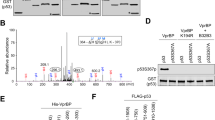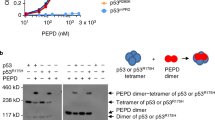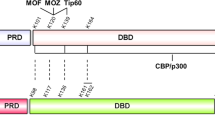Abstract
Mutation of four lysine residues in the p53 C-terminal domain inhibits MDM2-dependent ubiquitination of p53 and alters its subcellular distribution. This implies that modification (such as acetylation and phosphorylation) of amino acid residues in p53 C-terminal domain, regulate the biological functions of p53. In this study, we demonstrated that p53 with lysine residues 372, 373, 381, and 382 mutated to alanine (the A4 mutant) retained the transactivation activity of wild-type p53, although the transactivation activity of p21 promoter by the A4 mutant was slightly reduced. The inducible expression of wild-type p53 and the A4 mutant in H1299 cells caused growth inhibition due to cell-cycle arrest. Consistent with previous studies, the expression of wild-type p53 elicited G1 and G2 arrests. However, the cells expressing the A4 mutant underwent G1 arrest but not G2 arrest. Cyclin B1-associated kinase activity was reduced in cells expressing wild-type p53 but not A4, when the cells underwent G2 arrest. This suggests that modification of the p53 C-terminal domain might inhibit p53-mediated G2 arrest. In other words, p53 requires an intact C-terminus to induce G2 arrest.
This is a preview of subscription content, access via your institution
Access options
Subscribe to this journal
Receive 50 print issues and online access
$259.00 per year
only $5.18 per issue
Buy this article
- Purchase on Springer Link
- Instant access to full article PDF
Prices may be subject to local taxes which are calculated during checkout






Similar content being viewed by others
References
Agarwal ML, Agarwal A, Taylor WR, Stark GR . 1995 Proc. Natl. Acad. Sci. USA 92: 8493–8497
Chehab NH, Malikzay A, Stavridi ES, Halazonetis TD . 1999 Proc. Natl. Acad. Sci. USA 96: 13777–13782
Chen X, Ko LJ, Jayaraman L, Prives C . 1996 Genes Dev. 10: 2438–2451
Cox LS, Lane DP . 1995 BioEssays 17: 501–508
Gottlieb TM, Oren M . 1996 Biochim. Biophys. Acta 1287: 77–102
Gu W, Roeder RG . 1997 Cell 90: 595–606
Harper JW, Adami GR, Wei N, Keyomarsi K, Elledge SJ . 1993 Cell 75: 805–816
Hartwell LH, Weinert TA . 1989 Science 246: 629–634
Haupt Y, Barak Y, Oren M . 1996 EMBO J. 15: 1596–1606
Hermeking H, Lengauer C, Polyak K, He TC, Zhang L, Thiagalingam S, Kinzler KW, Vogelstein B . 1997 Mol. Cell 1: 3–11
Hunter T, Pines J . 1994 Cell 79: 573–582
Innocente SA, Abrahamson JL, Cogswell JP, Lee JM . 1999 Proc. Natl. Acad. Sci. USA 96: 2147–2152
Ito A, Lai CH, Zhao X, Saito S, Hamilton MH, Appella E, Yao TP . 2001 EMBO J. 20: 1331–1340
Kagawa S, Fujiwara T, Hizuta A, Yasuda T, Zhang WW, Roth JA, Tanaka N . 1997 Oncogene 15: 1903–1909
King RW, Jackson PK, Kirschner MW . 1994 Cell 79: 563–571
Ko LJ, Prives P . 1996 Genes Dev. 10: 1054–1072
Levine AJ . 1997 Cell 88: 323–331
Liu L, Scolnick DM, Trievel RC, Zhang HB, Marmorstein R, Halazonetis TD, Berger SL . 1999 Mol. Cell. Biol. 19: 1202–1209
Lopez-Girona A, Furnari B, Mondesert O, Russell P . 1999 Nature 397: 172–175
Nakamura S, Roth JA, Mukhopadhyay T . 2000 Mol. Cell. Biol. 20: 9391–9398
Oda K, Arakawa H, Tanaka T, Matsuda K, Tanikawa C, Mori T, Nishimori H, Tamai K, Tokino T, Nakamura Y, Taya Y . 2000 Cell 102: 849–862
Sakaguchi K, Herrera JE, Saito S, Miki T, Bustin M, Vassilev A, Anderson CW, Appella E . 1998 Genes Dev. 12: 2831–2841
Shieh SY, Ikeda M, Taya Y, Prives C . 1997 Cell 91: 325–334
Shieh SY, Taya Y, Prives C . 1999 EMBO J. 18: 1815–1823
Stewart N, Hicks GG, Paraskevas F, Mowat M . 1995 Oncogene 10: 109–115
Taylor WR, DePrimo SE, Agarwal A, Agarwal ML, Schonthal AH, Katula KS, Stark GR . 1999 Mol. Cell. Biol. 10: 3607–3622
Unger T, Juven-Gershon T, Moallem E, Berger M, Vogt SR, Lozano G, Oren M, Haupt Y . 1999 EMBO J. 18: 1805–1814
Wang XW, Zhan Q, Coursen JD, Khan MA, Kontny HU, Yu L, Hollander MC, O'Connor PM, Fornace AJJ, Harris CC . 1999 Proc. Natl. Acad. Sci. USA 96: 3706–3711
Wang Y, Blandino G, Oren M, Givol D . 1998 Oncogene 17: 1923–1930
Yun J, Chae HD, Choy HE, Chung J, Yoo HS, Han MH, Shin DY . 1999 J. Biol. Chem. 274: 29677–29682
Zhan Q, Antinore MJ, Wang XW, Carrier F, Smith ML, Harris CC, Fornace Jr AJ . 1999 Oncogene 18: 2892–2900
Acknowledgements
We thank Marjorie Johnson for her technical assistance, Maureen Goode, PhD (Scientific Publications Dept.) for editing assistance, and Carmelita Concepcion and Peggy James for preparation of this manuscript. This work was partially supported by grants from the National Cancer Institute and the National Institutes of Health (P01 CA78778-01A1) [JA Roth]; SPORE (2P50-CA70970-04); a developmental grant from the NCI for the University of Texas M. D. Anderson Cancer Center SPORE (P50-CA70907) in lung cancer (T Mukhopadhyay); by gifts to the Division of Surgery from Tenneco and Exxon for the Core Laboratory Facility; by the UT M. D. Anderson Cancer Center Support Core Grant (CA 16672); by a grant from the Tobacco Settlement Funds as appropriated by the Texas State Legislature (Project 8); the W. M. Keck Foundation; and a sponsored research agreement with Introgen Therapeutics, Inc. (SR93-004-1).
Author information
Authors and Affiliations
Corresponding author
Rights and permissions
About this article
This article is cited by
-
High anesthetic exposure leads to oxidative damage and gene expression changes in physicians during medical residency: a cohort study
Environmental Science and Pollution Research (2023)
-
Identification of PRC1 as the p53 target gene uncovers a novel function of p53 in the regulation of cytokinesis
Oncogene (2004)



